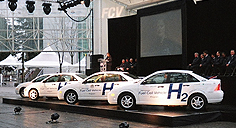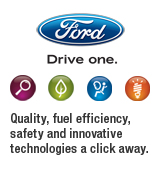One way we're harnessing the potential of hydrogen to power vehicles is by developing hydrogen fuel cell vehicles (FCVs). Hydrogen FCVs are more than twice as efficient as today's gasoline vehicles and produce zero emissions.

A Hydrogen FCV is an electric vehicle that uses hydrogen fuel instead of a battery to produce electricity. The fuel cell utilizes a catalyst to perform a chemical process (no moving parts) that combines oxygen from the air with hydrogen fuel to produce electricity.
Zero Emissions
Fuel cells hold the most promise for a new generation of vehicle propulsion technology that's efficient, silent and more environmentally responsible. Our prototype FCVs produce zero tailpipe emissions. Wondering what comes out of the tailpipe of a hydrogen FCV? Just water.
Safety
Safely storing hydrogen, which isn't inherently more dangerous than other fuels, requires appropriate caution. In our FCVs, hydrogen gas is safely stored in a pressurized tank capable of three times the specified storage pressure. Hydrogen is supplied to the fuel cell at less pressure than gasoline is to a fuel-injected engine.
Several safety systems have been designed for our prototype vehicles. The Focus FCV, for example, includes four hydrogen sensors: two in the trunk, one under the hood, and another in the passenger compartment. The vehicle safely shuts down upon detection of a hydrogen leak. In addition, eight small fans continually vent the vehicle during operation, filling, and when the fuel door is opened.
How Fuel Cells Work
In a direct hydrogen fuel cell vehicle, hydrogen from the fuel tank is supplied to the fuel cells, where it combines with oxygen from an air compressor. An electrode coated with a catalyst splits the hydrogen into electrons and protons. The movement of the electrons generates electricity, which is sent to the traction inverter module. The traction inverter module converts the electricity for use by the motor/transaxle, which transforms the electric energy into the mechanical energy that turns the wheels. The only byproducts of this process are water and heat.
A methanol fuel cell vehicle operates similarly, but also has a reformer to extract the needed hydrogen from the methanol.
Direct Hydrogen vs. Reformers
The most significant challenge facing the introduction of a production FCV is providing hydrogen to the stack module. There are two alternatives for supplying hydrogen for the proton exchange membrane:
1) Direct hydrogen stored onboard the vehicle or
2) Onboard reformation of hydrogen from liquid fuels, such as gasoline or methanol
Direct hydrogen provides the greatest environmental benefit and the simplest fuel cell system design, but requires the development of a hydrogen infrastructure. Onboard reformation of hydrogen utilizes a liquid fuel option with an established fueling infrastructure, but requires additional complex chemical fuel processing onboard the vehicle.



